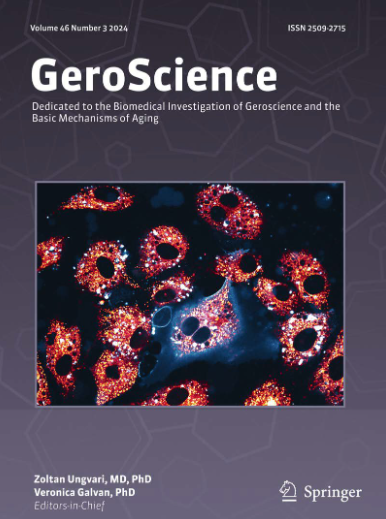A physically and mentally active lifestyle relates to younger brain and cognitive age.
IF 5.3
2区 医学
Q1 GERIATRICS & GERONTOLOGY
引用次数: 0
Abstract
Resistance to age-related pathological changes (brain maintenance), including Alzheimer's disease, cerebrovascular disease, and neurodegeneration may promote cognitive resilience in aging. However, how lifestyle and health profiles relate to successful cognitive and brain aging remains poorly understood. In a novel, deeply phenotyped cohort of 211 cognitively unimpaired older adults (age = 71.0 ± 7.4 years, 46% female), we characterized principal components of lifestyle and health using questionnaire, fitness, and blood data. We estimated cognitive age gap (CAG) based on comprehensive neuropsychological data and brain age gap (BAG) based on brain-pathology markers, including plasma biomarkers of Alzheimer's pathology (pTau217 and Aβ1-42/Aβ1-40), MRI-based measures of white matter hyperintensities, perivascular spaces, and brain atrophy. Regression analyses tested how the observed lifestyle-health profiles were related to CAG and BAG. Seven principal components explained 49% of the variance in health and lifestyle. The second component, characterized by a mentally and physically active life and low cardiovascular risk, was associated with lower CAG (β = - 0.66, p < 0.001) and BAG (β = - 0.52, p = 0.003), reflecting a younger-than-expected brain and cognitive age, respectively. The association of an active lifestyle and lower CAG was partially mediated by BAG. Higher CAG was also associated with other lifestyle components characterized by low mental stimulation. APOE-ε4 carriers exhibited higher BAG. In conclusion, a lifestyle combining low cardiovascular risk, high mental engagement throughout life and high physical activity/fitness is jointly associated with less-than-expected brain pathology and better-than-expected cognitive performance, supporting its involvement in brain maintenance and cognitive resilience to aging.身体和精神活跃的生活方式与年轻的大脑和认知年龄有关。
抵抗与年龄相关的病理变化(大脑维护),包括阿尔茨海默病、脑血管疾病和神经退行性疾病,可能会促进衰老过程中的认知弹性。然而,生活方式和健康状况与成功的认知和大脑衰老之间的关系仍然知之甚少。在一项由211名认知功能未受损的老年人(年龄= 71.0±7.4岁,46%为女性)组成的新颖、深度表型队列研究中,我们通过问卷调查、健身和血液数据表征了生活方式和健康的主要成分。我们根据综合神经心理学数据估计认知年龄差距(CAG),根据脑病理学标志物估计脑年龄差距(BAG),包括阿尔茨海默病病理的血浆生物标志物(pTau217和a - β1-42/ a - β1-40),基于mri的白质高信号、血管周围间隙和脑萎缩。回归分析检验了观察到的生活方式-健康状况与CAG和BAG之间的关系。七个主要因素解释了49%的健康和生活方式差异。第二个组成部分的特征是精神和身体活跃,心血管风险低,与较低的CAG (β = - 0.66, p < 0.001)和BAG (β = - 0.52, p = 0.003)相关,分别反映了比预期更年轻的大脑和认知年龄。积极的生活方式和较低CAG之间的关联部分是由BAG介导的。较高的CAG还与其他以低精神刺激为特征的生活方式成分有关。APOE-ε4携带者BAG较高。总之,结合低心血管风险、终生高精神投入和高体力活动/健康的生活方式与低于预期的脑部病理和优于预期的认知表现相关,支持其参与大脑维护和认知抗衰老能力。
本文章由计算机程序翻译,如有差异,请以英文原文为准。
求助全文
约1分钟内获得全文
求助全文
来源期刊

GeroScience
Medicine-Complementary and Alternative Medicine
CiteScore
10.50
自引率
5.40%
发文量
182
期刊介绍:
GeroScience is a bi-monthly, international, peer-reviewed journal that publishes articles related to research in the biology of aging and research on biomedical applications that impact aging. The scope of articles to be considered include evolutionary biology, biophysics, genetics, genomics, proteomics, molecular biology, cell biology, biochemistry, endocrinology, immunology, physiology, pharmacology, neuroscience, and psychology.
 求助内容:
求助内容: 应助结果提醒方式:
应助结果提醒方式:


